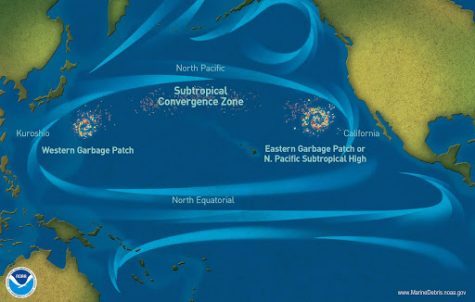Focusing on Plastic
Plastic.
It is everywhere.
It affects everything in people’s daily lives. It is used to store food as children play with it in the shape of dolls and action figures, yet no one is realizing that it is harming the planet.
Plastic is a known material that can be shaped into various items by molding it. It can be strong and can be stretched. It can be made from many raw materials. Most items that are found in the world are cigarettes, food containers, bottles, plastic bags and caps.
It is very cheap so throughout the years of living, it is common to see plastic everywhere and its ease-of-use. What people don’t realize is that plastic won’t get dissolved in land or water which means that plastic pollution is increasing at a very rapid rate.
According to Science Advances, plastic debris has been found in all major ocean basins, with an estimated 4 to 12 million metric tons of plastic waste generated on land entering the marine environment in 2010 alone. Plastic does not only affect humans but the environment and animal life. Presently, people are being cautious on what is bad for the Earth with new guidelines on public areas such as plastic bag banning and investing in a recycling infrastructure nationwide that can help with the day to day life.

Raissa Henry, 23, has a definite goal: a life without plastic. During her teenage years, she spent hours trying to find the best way to help the planet and make a drastic change until she came to the conclusion that the best way was to go little by little.
“I reached such a point of despair that I had to revive.”
This young woman’s project is to reuse rather than recycle.
Henry is a Behavioral Health Professional at a Specialized School in Queens. When she was only 12-years-old, she began to observe how her parents carried reusable bags to the supermarket and how they instilled concern for the environment on her and her brother. When she turned 18 and began to live alone in a residence for women, she began to investigate more about plastic and its consequences on the planet.
“I was truly blown away after watching a few documentaries. It really changed my life at that moment.”
Henry discovered how our planet is facing a crisis of catastrophic proportions, with the potential to affect the lives of generations to come.
More than 99 percent of plastic is made from fossil fuels and plastic production is estimated to double in the next three decades, according to the Center for International Environmental Law. Furthermore, reports predict that plastic pollution in the sea is likely to triple over the next decade. What is driving this crisis is the fact that many plastics are made to be used once and then disposed of, creating pollution, overburdening our communities and ecosystems, and overwhelming systems designed to handle waste.
In the 1970s, since people began mass production of plastic, with more than 8 billion metric tons have been manufactured and more than 6 billion metric tons of plastic waste were produced, according to a 2017 article in the Science Advances magazine. According to 2018 data from the Environmental Protection Agency, only 9 percent of the plastic people throw away in those blue containers is actually recycled. The vast majority of our plastic ends up in our landfills and natural environments or is incinerated to become carbon pollution in our air.
Realizing these numbers and the damage that plastic was doing not only to the land but also to living beings, especially marine life, Raissa began to act.
She started supporting companies like TerraCycle or United By Blue that are dedicated to eliminating the trash from the oceans and lands. She spoke to her friends and family and begged them to read the news she sent them. She went to parks to clean up all kinds of garbage. But none of this felt enough.
“I was very overwhelmed. I wanted people to worry like me.”
But over time, Henry learned that “I can’t change the world, but I can do my bit.”
Henry decided to focus on her way to avoid plastic pollution and not use plastic as much as she can. She buys her home utensils in Package Free, an ecosystem of brands on a mission to make the world less trashy. Any type of product that she needs for the bathroom, bedroom, kitchen or laundry, she buys it in this sustainable products store.
One of the main reasons why many people are reluctant to try to give up plastic is because of the price of buying metal, glass or wood products. They think it will affect their economy a lot.
Henry then explained how using less plastic and buying reusable products affects her grocery spending for the better.
“Of course, my razor was $38 instead of $10, but I can use that one for the rest of my life and I don’t need to buy a new one every month.”
Henry explained how one day she began to think about the number of products she had stopped buying (in addition to processed food) since she started her journey to abandon plastic.
She was surprised when making the list: aluminum foil, straws, picks to close the bags, garbage bags, cotton wool, raisers, cotton swabs, deodorant, scrubbers, glass cleaner, exfoliating creams and gels.
“Sometimes I just think of the advantages for the planet instead of prices,” shared Henry, “this is our home. There is no other place for us or for the future generations, so we need to take care of it.”
Since the dawn of history, humans have strived to create materials that offer benefits that natural material lacks. Surprisingly, plastic creation came about by chance, like many of the great discoveries of history. It arose as a result of a contest held in 1860, when the American company, Phelan & Collender, offered a reward of $10,000 to whoever obtained a substitute for natural ivory, which was what billiard balls were made of at that time. One of the participants, John Wesley Hyatt, developed celluloid. Although Hyatt did not win the award, he came up with a highly commercial product that would be vital to industrial development in the late 19th-century. In 1909, the American chemist Leo Hendrik synthesized a polymer of great commercial interest from phenol molecules. It was coined “Bakelite,” and it was the first fully synthetic plastic in history. It was the first of synthetic resins that revolutionized modern technology, initiating the “era of plastic.”
Throughout the 20th century, the use of plastic became prevalent, and daily life changed radically as it replaced other materials both in domestic and industrial settings. This material’s consumption was greatly expanded thanks to its resistance, its low cost, and its versatility.
However, plastic consumption is so widespread today that it has become an environmental problem since plastic is a non-biodegradable material.

When plastic is thrown into the ocean, it dangers the environment living in the sea. The plastic bags can wrap around the coral and could even kill sea turtles. It is commonly known that sea turtles are likely to die by plastic since they mistake plastic for jellyfish. There have been many animals that have died due to plastic and are seen washed up on shore with plastic bags covering them seeing as the animals trying to escape. Plastic can kill up to 1 million seabirds in a year and while the seabirds eat it, it can take up a lot of room in their stomach which can cause them to starve. About 60% of sea birds have ingested plastic in their lifetime. After the animals eat the plastic and die, the plastic comes back out of the animals and happens to another creature.
Plastic also pollutes the beaches and litters the shores. This can be a huge cost for taxpayers because it will go to clean the trash in public areas. It can prevent storm drains and tourism revenue. When the plastic enters the water, it adds to and creates the Great Pacific Garbage Patch.
The Great Pacific Garbage Patch is the largest of the five offshore plastic calculation zones in the world’s oceans. The GPGP estimates that the amount of garbage that is in the ocean is about 1.6 million kilometers which can be seen as three times the size of France.

People have been using plastic bags for years now and it was used a lot because it was a quick and easy way to carry things. It has been used in restaurants and stores and no one has realized the damage that it has been doing to the earth. As seen in other countries, plastic bags have been ban from being used in stores. For New York State, the plastic bag ban was effective on March 1, 2020, by The New York State Supreme Court. Their motive was to eliminate plastic bags that can affect communities and the environment. Especially in a big city like New York, where the city is filled with people and plastic bags can be stuck in trees, as well being littered in the neighborhoods and the sewer system.
New York State officials stated “As of March 1, 2020, all plastic carryout bags (other than an exempt bag) became banned from distribution by anyone required to collect New York State sales tax. For sales that are tax-exempt, plastic carry-out bags are still not allowed to be distributed by anyone required to collect New York State sales tax (unless it is an exempt bag). The law affects anyone required to collect New York State sales tax, bag manufacturers, and consumers.
New York is promoting residents to bring their own bags for when they shop to help prevent bag waste.
It may be seen to people that plastic pollution is a problem because not anything major happened that affected the Earth. But as seen now, garbage can lead to animals being contaminated and can lead to a virus. There are solutions that are being researched and now than ever, plastic pollution is being taken seriously.
For more information, visit thee following:
https://theoceancleanup.com/great-pacific-garbage-patch/
https://advances.sciencemag.org/content/3/7/e1700782.full
https://www.dec.ny.gov/chemical/50034.html

Gino Alva is a junior majoring in Journalism. Gino is an avid fan of the New York Yankees, Real Madrid and Manchester United. Soccer played a huge part...

Daniela was born and raised in Barcelona, Spain. In the fall of 2016, she moved to the US with her family. This became a major turning point in Daniela’s...








